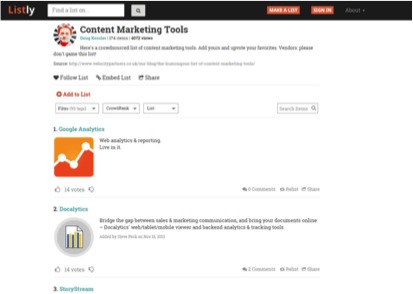Our test of the Listly plugin on this blog represents every marketer’s dilemma of the need to weigh the benefits of opportunity and change against the potential drawbacks.
Listly’s appeal to inbound marketers
For those who haven’t heard of it, Listly is a social tool that allows for collaborative list curation. One of the most attractive features of Listly for inbound marketers is being able to embed the lists that you create on Listly on your blog. Embedded lists retain the functionality of the Listly site itself so readers can like, vote or add to items in a list.
Six months ago, we decided to test that function by embedding a list in a Change Conversations post using a curated list of active tweeters on sustainability issues, our findings gave us mixed reviews on whether or not Listly was worth continuing.
Listly, WordPress and the plugin dilemma
When it comes to WordPress plugins, less is truly more. Anytime you add code to your blog it will increase the page load time, therefore adding a plugin will inherently slow down your blog, and when the plugin calls for content to be served from a remote site, this is an even greater risk. Now, depending on the plugin, this may mean that only a fraction of a second is added to the page load time, but with page speed a factor weighed in the Google SEO algorithm, every millisecond counts. WordPress users need to be more selective than ever when installing plugins. So, when we started optimizing our blog content after the latest Google algorithm change to check the speed of our blog, we received some unhappy news – our Listly WordPress plugin was slowing down our blog.
The decision we’re left with
When we learned that Listly was one of the main factors slowing down our blog we immediately asked the question: should we keep or ditch Listly? Our initial instinct from an SEO standpoint was to get rid of it immediately. And while that certainly remains valid, we decided that before we kicked Listly to the proverbial curb we should do more research. What we found certainly gave us something to think about.
The incredible benefits of Listly
Though our initial instinct was to add Listly to the SEO “plugin hit list”, what we confirmed was just how many advantages there are to embedding Listly lists. Listly is, ironically enough, a SEO machine and blog traffic generator by nature, and here’s why:
- Listly allows users to add to lists and also cast their votes within lists. This keeps the content fresh and constantly changing.
- Listly embeds in HTML format, which means your blog gets all the extra SEO benefits of the content itself (versus using an image, which carries no SEO value for its text).
- Listly, by nature, keeps users coming back to check to the original list to see if the list item they voted for reached the top of its respective list – driving traffic.
- People love sharing lists, which makes them highly viral.
Decisions, decisions
In the end, we decided to keep Listly for now, not because we stopped caring about the plugin slightly slowing our blog down, but because we saw the potential that Listly has to help drive traffic to our blog while improving our SEO. With that settled (for now), we decided to focus on further optimizing the images on our blog, and to start improving our Listly page to make it more interesting and attractive. It was not an easy choice and there were trade-offs, but in the end, I believe we made the right decision. We’d love to hear about your experience with Listly, or other plugins that call a remote site.
Meanwhile, expect to see more lists in the near future from the Change Conversations team!
———
Dan Frost hails from Massachusetts and is a student at the University of Vermont, up the hill from our waterfront offices in Burlington.
—–
photo credit: Mykl Roventine via flickr: Creative Commons license





is there any other way to create a stylish top list in a post?